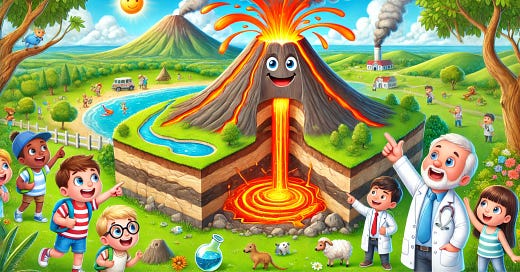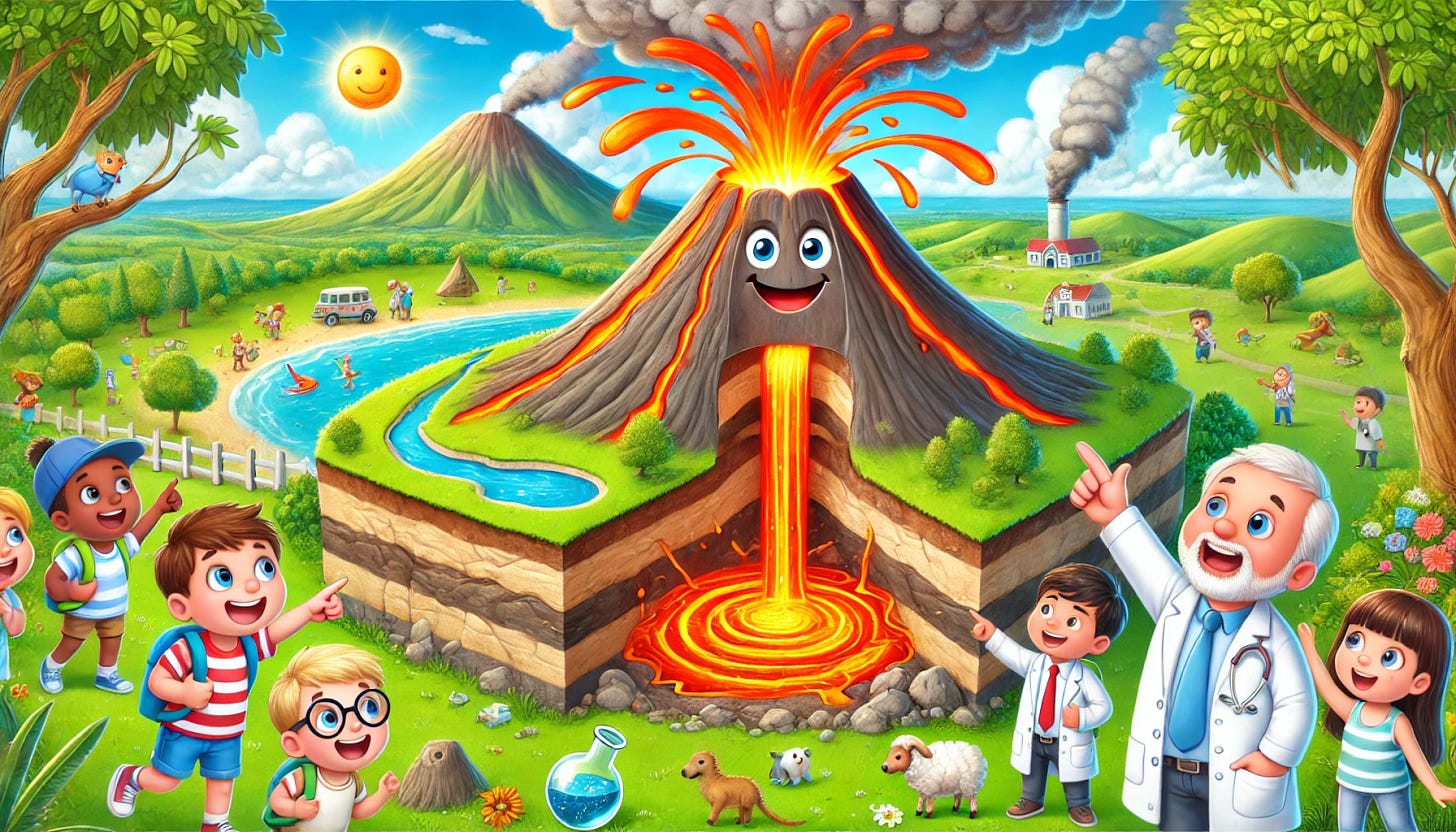What Makes a Volcano Erupt?
Have you ever seen a volcano in action? Imagine a mountain with glowing lava shooting out of the top and spilling down the sides. It might sound a little scary, but it’s also one of the most exciting and powerful natural events on Earth! But have you ever wondered, What makes a volcano erupt? What causes all that hot lava, ash, and steam to shoot up into the sky? In this article, we’re going to find out all about volcanoes, how they erupt, and why they do it.
Hello my friends!
For a quick note, welcome to Tidbits with Titus, a podcast and newsletter where we tackle the big, curious questions kids ask every day in fun, bite-sized ways! I’m Alexander Titus, but I go by Titus. I’m a scientist, adventurer, and a huge fan of making science, technology, and life accessible to all ages. From “How does electricity work?” to “What are taxes?” and even “Why is the sky blue?” I’m here to dive into these wonder-filled questions with engaging stories and simple explanations that spark curiosity and make learning a joy. This effort is all about creating a space where families can learn together, discover the magic of the every day, and find thoughtful ways to explore the world’s big mysteries. Let’s make curiosity a family tradition—one tidbit at a time!
Just so you know, these podcast episodes are all AI-generated using Google’s really cool NotebookLM technology. That means there are some errors in how words are said, but that is part of the fun!
If your little ones have questions that you want help answering, shoot me an email at questions@tidbitswithtitus.com and I’ll see what I can do!
You can subscribe to the newsletter that has this information as well at tidbitswithtitus.com.
Also please share with anyone you think would be interested. The more the merrier!
Cheers,
-Titus
1. What Is a Volcano?
A volcano is a hole or crack in the Earth’s surface where hot rocks, gas, and ash can escape from inside the Earth. The Earth has different layers, and one of them is called the mantle. The mantle is made up of super-hot, melted rock called magma. When magma escapes from the mantle, it rises up through the Earth’s crust (the outer layer of the Earth) and reaches the surface, where it turns into lava.
Lava is the hot, glowing liquid that erupts from a volcano. When the lava cools down, it hardens and becomes solid rock. Over time, if a volcano erupts many times, it can build up into a large mountain made of rock and lava called a volcanic cone.
2. What Happens Inside the Earth?
Before we understand how a volcano erupts, let’s take a look at what’s going on inside the Earth. The Earth is like a giant ball made up of different layers:
The Core: The very center of the Earth is called the core. It’s extremely hot, with temperatures that can reach over 9,000 degrees Fahrenheit (5,000 degrees Celsius)! The core is made mostly of metals like iron and nickel.
The Mantle: The next layer is the mantle. The mantle is made of hot, melted rock called magma. The magma is so hot that it flows like thick, sticky honey. Sometimes, the magma tries to push its way through cracks in the crust to get out.
The Crust: The crust is the outermost layer of the Earth. It’s made up of solid rock and is where we live. The crust is like a thin shell on top of the hot, melted mantle. The crust is cracked into pieces called tectonic plates, and these plates are always moving around, but they do so very slowly.
The movement of these tectonic plates is what causes volcanoes to form and erupt.
3. How Do Volcanoes Form?
Volcanoes are formed when magma from the mantle pushes through the crust and comes to the surface. But how does the magma get out? Well, the tectonic plates (remember, they’re like huge pieces of a jigsaw puzzle) move in different directions. Sometimes, the plates move apart, which allows magma to rise through the gap. Other times, the plates crash into each other, which can cause the magma to push up and break through the crust. This is how a volcano begins to form.
When the magma breaks through the Earth’s crust, it is called lava once it reaches the surface. The lava flows down the sides of the volcano and can cover large areas of land. Over time, the lava cools down and hardens, forming rock. If the volcano keeps erupting, it can build up into a tall, steep mountain made of layers of lava and ash.
4. Why Do Volcanoes Erupt?
Now that we know how volcanoes are formed, let's explore why they erupt in the first place. Volcanoes don’t just erupt because they want to—they are trying to release pressure that builds up inside the Earth.
Remember that magma is hot and very thick, kind of like hot syrup. It wants to rise to the surface because heat rises, but sometimes it gets trapped in the mantle. As more and more magma builds up, the pressure gets higher and higher, and eventually, the magma forces its way through the Earth’s crust. When the pressure gets too high, it can cause the volcano to erupt!
So, volcanoes erupt because the magma is trying to escape from deep inside the Earth. When the pressure becomes too much, the volcano bursts open, sending hot lava, ash, and gas into the air.
5. What Happens During an Eruption?
When a volcano erupts, it releases three main things:
Lava: Lava is the hot, molten rock that comes out of the volcano. It is often bright orange or red and can be very dangerous. When lava cools down, it turns into solid rock.
Ash: Ash is tiny pieces of rock and dust that are blown into the air during an eruption. Ash can travel for miles and can cover the ground, making it hard to see or breathe. It can even cause buildings to collapse if it piles up too much.
Gas: Volcanoes also release gases like carbon dioxide, sulfur dioxide, and water vapor. These gases can be dangerous to breathe, and they can also create large clouds that block out the sun and make the air cooler for a while.
During an eruption, the lava can flow down the sides of the volcano, while ash and gas shoot high into the sky. Sometimes, the volcano can even cause pyroclastic flows, which are fast-moving clouds of hot gas, ash, and rock that move down the volcano at incredible speeds.
6. Types of Volcanic Eruptions
Not all volcanic eruptions are the same. Some eruptions are small and gentle, while others are violent and explosive. There are different types of eruptions, and each one is a little bit different.
Hawaiian Eruptions: These eruptions are usually gentle. Lava flows slowly down the sides of the volcano, and there is very little ash. These eruptions happen when the magma is thick and sticky, so it doesn’t explode. Instead, it oozes out of the volcano slowly.
Strombolian Eruptions: These eruptions are a bit more explosive. Lava bursts out of the volcano in small, fiery explosions. This type of eruption happens when the magma is less sticky and can move more easily.
Vesuvian Eruptions: These eruptions are very violent and can cause huge explosions. They happen when magma is thick and traps gases, causing a lot of pressure to build up. When the pressure is released, the volcano erupts in a big burst of lava, ash, and gas. These eruptions can be very dangerous.
Plinian Eruptions: This is the most explosive type of eruption. It can send ash and gas high into the sky, and the eruption can last for hours or even days. These eruptions can cause massive destruction and affect the weather.
7. Famous Volcanic Eruptions
Volcanic eruptions have been happening for millions of years, and some of them are famous because they caused a lot of damage or changed the world in some way. Let’s take a look at a few famous eruptions.
Mount Vesuvius (Italy, AD 79): One of the most famous volcanic eruptions in history was the eruption of Mount Vesuvius. This volcano erupted suddenly and buried the Roman cities of Pompeii and Herculaneum under tons of ash. The eruption was so powerful that the cities were preserved for centuries, and archaeologists have learned a lot about life in ancient Rome by studying these ruins.
Mount St. Helens (USA, 1980): In 1980, Mount St. Helens erupted in Washington State. The eruption was very violent and caused a huge landslide. The volcano released ash and gases into the air, and the surrounding area was covered in volcanic debris. It took years for the area to recover.
Krakatoa (Indonesia, 1883): The eruption of Krakatoa was one of the most violent eruptions ever recorded. It caused massive waves and earthquakes, and the explosion could be heard thousands of miles away. The eruption also caused a huge drop in temperature around the world, making the following year one of the coolest on record.
Eyjafjallajökull (Iceland, 2010): In 2010, the eruption of Eyjafjallajökull caused huge ash clouds that affected air travel across Europe. The ash spread so far that many airports had to close for days, affecting millions of people. The eruption was a reminder of how powerful volcanoes can be!
8. How Are Volcanoes Monitored?
Volcanoes are constantly monitored by scientists to keep people safe. Scientists look for signs that a volcano might erupt, such as earthquakes, gas emissions, and changes in the shape of the volcano. These signs can help scientists predict when an eruption might happen, giving people time to evacuate and stay safe.
Volcanoes are also studied to learn more about the Earth’s interior. By understanding how volcanoes work, scientists can learn more about the mantle, the crust, and even the core of the Earth.
9. Conclusion
Volcanoes are powerful, fascinating natural wonders. They form when magma pushes through cracks in the Earth’s crust and erupts as lava, ash, and gas. Volcanoes erupt because the pressure inside the Earth builds up and forces the magma to escape. While volcanoes can be dangerous, they also help shape the Earth’s landscape and provide new land for plants and animals to live on.
So, the next time you see a volcano, remember that it’s not just a mountain—it’s a place where the Earth is alive and constantly changing! And the next time you hear about an eruption, you’ll know exactly what makes a volcano erupt and why it happens.














Share this post